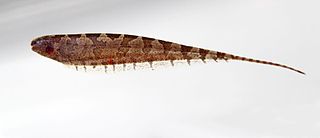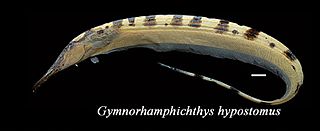
The Cetopsidae are a small family of catfishes, commonly called the whale catfishes.

Baryancistrus is a genus of freshwater Loricariid catfish. They inhabit flowing sections of rivers, especially clearwater, in the basins of the Amazon and Orinoco in Brazil and Venezuela. The largest species reach up to 34 cm (13 in) in total length.

The threadfin acara, also known as Heckel's thread-finned acara, is a South American species of cichlid fish. It is the only member of the genus Acarichthys and is native to rivers in the Amazon and Essequibo basins in tropical South America, and has become established in southeastern Asia. It is sometimes found in the aquarium trade.

Cynodontinae is a subfamily of tropical and subtropical South American fishes of the family Cynodontidae. They are characterized by an oblique mouth and very long distinct canines, which are used to capture and stab their prey, other fish that can be up to half the length of the cynodontine itself. They are not prized as food fish, but are important in subsistence and commercial fisheries. Hydrolycus are game fish, having been recently added to the International Game Fish Association in the fly and rod class. Cynodontid fish are also sometimes housed in aquaria.
Ancistomus is a genus of suckermouth armored catfishes found in shallow waters in rapidly flowing rivers in the southeastern Amazon basin in Brazil.

The striped Raphael catfish is a catfish of the family Doradidae. It may also be called Southern striped Raphael, talking catfish, chocolate doradid, chocolate catfish or thorny catfish. It is native to the Amazon, Paraguay–Paraná and lower Orinoco basins in South America. This peaceful, nocturnal species is a popular aquarium fish due to its pleasant temperament and curious nature. Despite its name "talking catfish", it does not speak.

Leiarius is a genus of long-whiskered catfishes native to South America. Most of the genus' species are found in the aquarium hobby as ornamental fish.

Pseudacanthicus is a genus of medium to large-sized suckermouth armored catfishes native to South America, where found in the Amazon and Orinoco basins, as well as rivers of the Guianas. They are primarily found in fast-flowing waters, sometimes relatively deep. They are sometimes kept in aquariums.

Myloplus schomburgkii, also known as the Disk tetra, Disk pacu, Black-ear pacu, Black-band myleus or Black-barred myleus is a species of serrasalmid with a black bar on its side. This species is found in the middle and lower Amazon River basin, Nanay River, upper Orinoco River basin in Brazil, Peru, Venezuela and possibly in Suriname.

Chalceus is a genus of fish that inhabits freshwater habitats in South America. Members can be found in the Amazon and Orinoco basins, as well as in the Guianas and various tributaries of the former. It is the sole representative of the family Chalceidae.

Myloplus is a genus of freshwater fish in the family Serrasalmidae found in tropical and subtropical South America, where they inhabit rivers and streams. They are primarily herbivores, but also take some animal matter. Depending on the exact species, they reach up to 16–56 cm (0.5–1.8 ft) in standard length. Adult males have a double-lobed anal fin and filamentous extensions on the dorsal fin, and both sexes can be brightly colored when breeding.
Tometes is a genus of fish in the family Serrasalmidae found in fast-flowing rivers in northern South America. Adults of all seven species in this genus are phytophagous, feeding primarily on aquatic plants in the family Podostemaceae.

Crenuchus spilurus, the sailfin tetra, is a species belonging to the South American darter family, Crenuchidae. It is found in the Amazon and Orinoco Basins, as well as various river Basins in the Guianas. It is the only member of its genus.

Hydrolycus is a genus of large dogtooth characins from tropical South America, where found in the Amazon and Orinoco basins, as well as rivers of the Guianas. The genus includes the largest dogtooth characins, reaching up to 1.17 m (3.8 ft) in length. They have long, pointed teeth used for spearing their prey, generally smaller fish. In a study of the stomachs of 45 individuals, most were empty, but among the remaining the prey fish were 15–50% of the length Hydrolycus itself.

Sternarchorhynchus is a genus of ghost knifefishes with a long, decurved snout that are found in river basins in tropical South America.
Hypopygus is a genus of South American gymnotiform knifefishes native to the Amazon, Orinoco and upper Paraguay basins, as well as rivers in the Guianas. They are often common, and found near submerged roots, aquatic vegetation and leaf-litter in streams, edges of rivers and floodplains. They are regularly found among vegetation in floating meadows, a habitat that often contains little oxygen, but they are well-adapted to this.

Steatogenys is a genus of gymnotiform knifefishes found in the Amazon, Orinoco and Essequibo river basins in tropical South America. The widespread and common S. elegans is found in a wide range of habitats, from the shallow essentially static waters such as floodplain lakes to fast-flowing rivers as deep as 50 m (160 ft). The two remaining species are less common and widespread, with A. duidae found mainly in small streams running through terra firme forests and S. ocellatus among submerged roots and branches in static or slow-flowing blackwater habitats. All three are regularly found among vegetation in floating meadows, a habitat that often contains little oxygen, but they are well-adapted to this.

Gymnorhamphichthys is a genus of South American sand knifefishes found in the Amazon, Araguaia, Orinoco and Río de la Plata basins, as well as rivers in the Guianas. They inhabit both small streams and large rivers, but usually over a sandy bottom. During the night they swim head-down over the sandy bottom to locate small invertebrate prey like insect larvae and during the day they rest buried under the sand.

Eigenmannia is a genus of fish in the family Sternopygidae native to tropical and subtropical South America, and Panama. They are typically found in slow-flowing streams, along the edge of large rivers, in deep river channels and in floodplains, and the genus also includes E. vicentespelaea, the only cave-adapted knifefish. Eigenmannia are often found near submerged roots, aquatic plants and floating meadows.

A clearwater river is classified based on its chemistry, sediments and water colour. Clearwater rivers have a low conductivity, relatively low levels of dissolved solids, typically have a neutral to slightly acidic pH and are very clear with a greenish colour. Clearwater rivers often have fast-flowing sections.

















